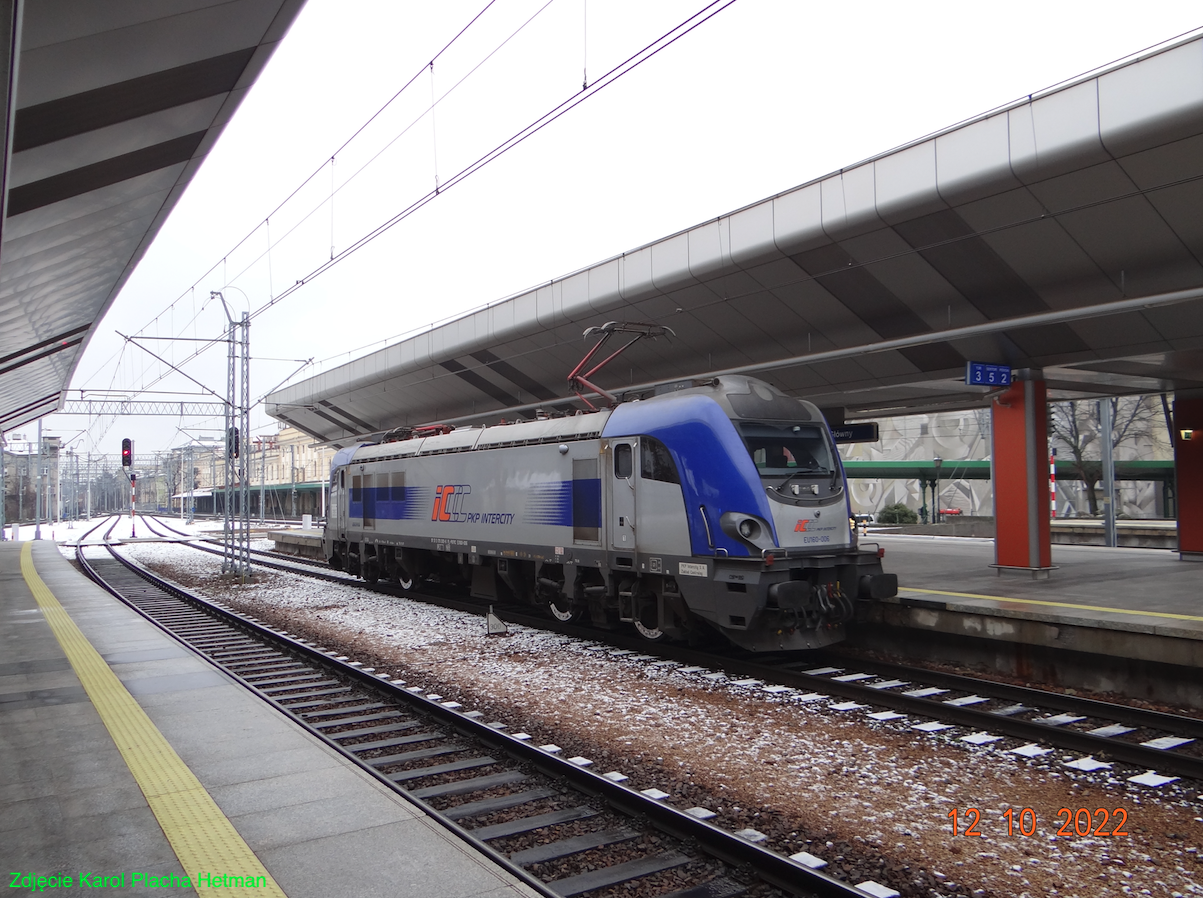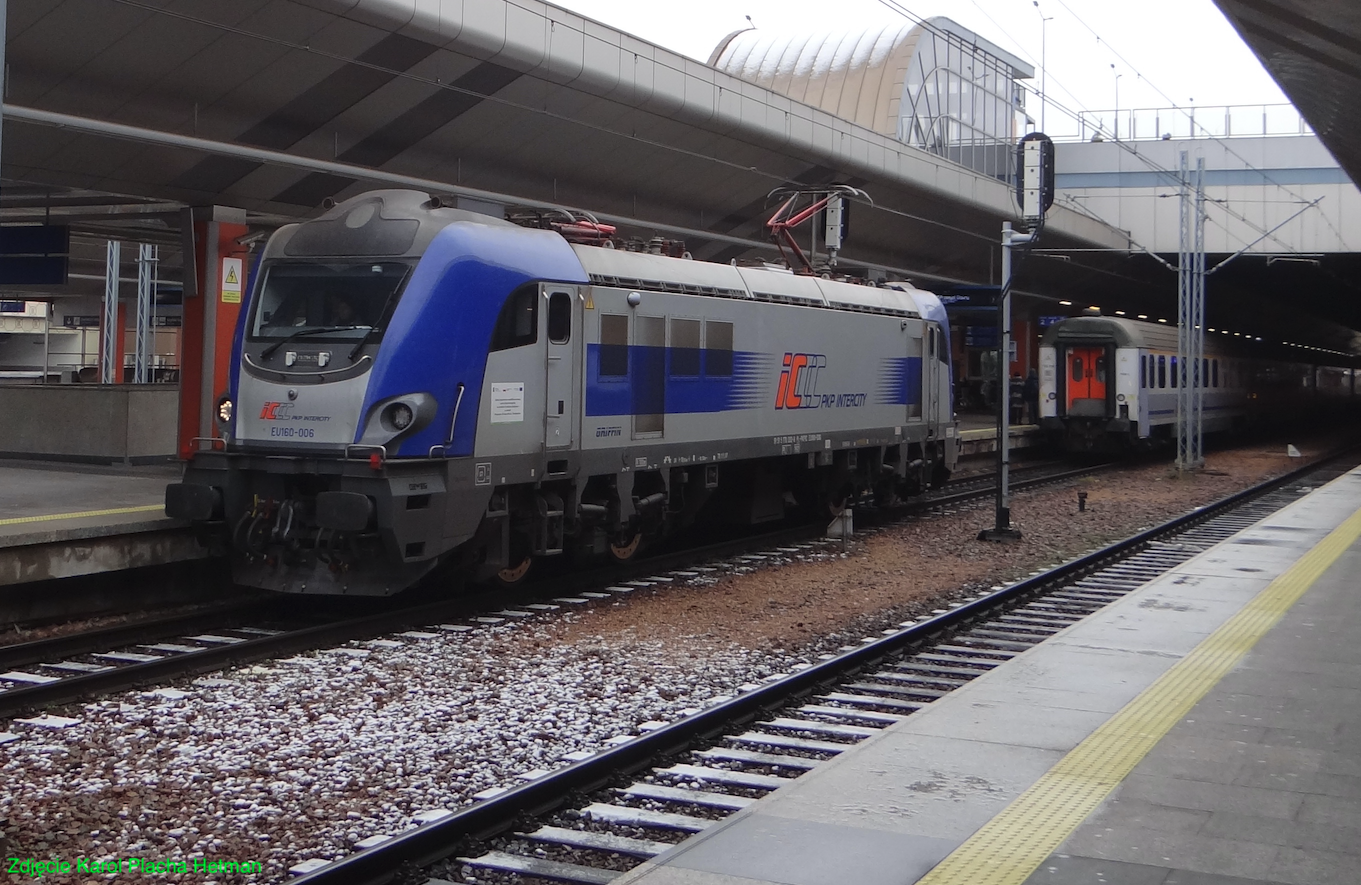Kraków 2023-10-25
Newag Griffin EU160 Electric Locomotive. E4MSUa-001.


Another speed record for a Polish rail vehicle. October 20, 2023.
On the night of October 19-20, 2023, the Polish electric locomotive reached a speed of 240 km/h. The Newag Griffin E4MSUa-001 locomotive ran at a speed of 240 km/h on the test track, although the locomotive is to be certified for a cruising speed of 200 km/h. The locomotive is multi-system, i.e. it can be powered by the following voltages: 3kV DC, 15kV AC and 25kV AC. Thanks to this, the locomotive will be able to drive trains in the Czech Republic, Slovakia, Austria, Hungary, and Germany. At the end of September 2023, tests of the new Newag Griffin E4MSUa-001 locomotive began on the Central Railway Main Line, near Góra Włodawska. Reaching a speed of 240 km/h was one of the elements of certification. Currently, only ED250 "Pendolino" electric multiple units drive equally fast on a daily basis in Poland.
In 2024, Newag Griffin E4MSUa locomotives will run international trains Warsaw - Berlin, Przemyśl - Berlin, Gdynia - Berlin, Gdynia - Warsaw - Katowice - Vienna (on the section to the Czech Bohumín station). The locomotives will also be used to service domestic routes, on modernized railway lines. Ultimately, the locomotives will be approved for six countries, thanks to which they will run wagon trains not only in Poland.
The contract was concluded between InterCity and Newag in October 2021. 10 multi-system locomotives were ordered, with an option for another 5 units. In June 2023, these five locomotives were purchased. The value of the order increased from PLN 258.6 million to PLN 388 million.
Newag Griffin EU160 Electric Locomotive.
Newag Griffin is a series of Polish locomotives designed and manufactured by Newag, which has its headquarters in Nowy Sącz. Newag Griffin is a new quality of traction vehicles adapted to user requirements. A common feature of all Griffin vehicles is the Bo′Bo′ axle system and the handling of various passenger and freight trains, with a maximum train weight of 3,200 tons. Griffin locomotives can be single-system electric, multi-system electric, electric with an additional combustion engine or internal combustion. This gives users a range of transport and technical options.
Description of the Griffin locomotive.
The GRIFFIN multi-system electric locomotive is the first traction vehicle from the platform of four-axle electric and diesel locomotives, giving users a whole range of transport and technical possibilities. The locomotive is designed to drive freight trains weighing up to 3,200,000 kg at a speed of up to 140 km/h, and passenger trains at a speed of up to 200 km/h. Newag has high standards confirmed by certificates, including: The International Railway Industry Standard IRIS (production, design, development and maintenance activities for locomotives) and PN-EN ISO 9001:2009 guarantee the highest European quality of GRIFFINA.
The technical parameters of the GRIFFIN locomotive have been adapted to the individual needs of users. It is characterized by the highest level of safety, rich equipment, high driver comfort and an intelligent energy management system. Thanks to its modular structure, GRIFFIN is offered in several versions based on the maximum number of common components. Powering the engines through converters built using IGBT technology, an on-board diagnostic system with full visual information and a data recording module, a camera system, adaptation to the installation of ERTMS and GSM-R devices, these are just some of the basic features of the GRIFFIN locomotive. By meeting EU and UIC requirements, the locomotive has not lost its next most important advantage, i.e. competitive price.
GRIFFIN locomotives run freight trains weighing up to 3,200,000 kg and passenger trains weighing up to 800,000 kg. Asynchronous, brushless motors were used, powered by converters built using IGBT technology. The locomotive has: a microprocessor control system, an on-board diagnostics system with full visual information and a data recording module, an intelligent energy management system, a high technical availability rate, adaptation to the installation of ERTMS and GSM-R devices, modular structure, the highest level of safety, a spacious cabin compliant with EN 1527 standards, high comfort of work for the driver (mechanics), rich social equipment, attention to environmental protection, high economics of use, attractive price.
Drive unit: monoblock wheels with a nominal rolling diameter of 1,250 mm, brake discs mounted on both sides of the wheel, asynchronous squirrel-cage traction motors with a power of 1,400 kW each, independent cooling of each engine, helical gear, axle boxes: cone bearings, speed and temperature sensors.
Spring relief system: First stage: two sets of coil springs mounted directly on both sides of the wheel set axle box. Second stage: a set of large-size "flexicoil" spiral springs. Hydraulic shock absorbers to dampen vibrations.
Locomotive body: self-supporting welded structure, controlled crumple zones, driver's cab safety cage, anti-climbing system, modular structure, three roof sections enabling easy access to the machinery space, ergonomic, two-person locomotive cabin, two-module air-conditioning system, four cameras acting as rear-view mirrors, two cameras transmitting images of drawbar hooks and screw couplings, a modern fire detection and extinguishing system.
HV electrical circuits: Two or four half current collectors with their own control system and auto-drop system. Reliable UR26 quick switch from Secheron. Anti-interference filters. Traction transformer to reduce the voltage taken from the 15kV/16.7Hz or 25kV/50Hz traction network to the voltage supplying the inverter inputs. Two drive power blocks, each containing two AC/AC converters - three-phase inverters with IGBT transistors and a DC/DC converter for regulating the electrodynamic braking force. Static converter with a power of 2 x 130 kW and output voltages of 3 x 440 V AC, 60 Hz and 24 V DC. Individual liquid cooling system for each of the two power blocks.
LV electrical circuits: 24 V DC voltage obtained from an additional battery charger powered by 3×440 V. Power supply: control circuits, quick switch, measurement converter control system, battery charging system, devices on the control panel, pneumatic system control, internal and external lighting , windshield wipers. Top-class battery with a capacity of 335Ah, made of FNC fiber technology. The lack of power in the overhead line does not result in the external lighting being turned off for a minimum of 5 hours. In the idle state, the control system turns off unnecessary receivers, saving electricity.
Locomotive control and diagnostics: Control system implemented in microprocessor technology. Vehicle main controller in a distributed structure. Drive controller. In each cabin there are two independent panels for displaying driving parameters and diagnostics. Event recorder that functions as a speedometer. Possibility to install a GPS system transmitting diagnostic data. Functions: Supervision of locomotive operation. Applying tractive force. Full automation of the driving process while maintaining the speed set by the driver. Starting and braking processes controlled by the anti-skid system with individual action on each wheel set. Pneumatic system control. Electrodynamic braking force regulation. Full locomotive diagnostics with event registration.
T-T data of the E4MSU locomotive:
Bo'Bo' axle system. DC 3 kV AC 15 kV 16.7 Hz AC 25 kV 50 Hz. Continuous power 5.6 MW. Maximum train weight 3,200,000 kg. Maximum speed 160 / 200 km/h. Speed of a train with a gross mass of 2,400,000 kg 135 km/h. The speed of a train with a gross mass of 2,400,000 kg on a ramp is 6 per mille 80 km/h. Service weight of the locomotive is 88,000 kg. Maximum axle load 220 kN. Wheel diameter 1,250 mm. Locomotive length 19.90 m. Gauge UIC 505-1.
Written by Karol Placha Hetman
